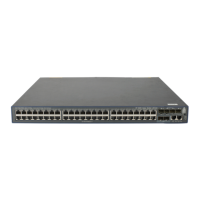128
A CSNP describes the summary of all LSPs for LSDB synchronization between neighboring routers. On
broadcast networks, CSNPs are sent by the DIS periodically (every 10 seconds by default). On
point-to-point networks, CSNPs are sent only during the first adjacency establishment.
A PSNP only contains the sequence numbers of one or multiple latest received LSPs. It can acknowledge
multiple LSPs at one time. When LSDBs are not synchronized, a PSNP is used to request missing LSPs from
a neighbor.
CLV
The variable fields of PDU comprise multiple Code-Length-Value (CLV) triplets.
Figure 37 CLV format
Table 5 shows that different PDUs contain different CLVs. Codes 1 through 10 are defined in ISO 10589
(code 3 and 5 are not shown in the table), and others are defined in RFC 1195.
Table 5 CLV codes and PDU types
CLV Code Name PDU T
e
1 Area Addresses IIH, LSP
2 IS Neighbors (LSP) LSP
4 Partition Designated Level 2 IS L2 LSP
6 IS Neighbors (MAC Address) LAN IIH
7 IS Neighbors (SNPA Address) LAN IIH
8 Padding IIH
9 LSP Entries SNP
10 Authentication Information IIH, LSP, SNP
128 IP Internal Reachability Information LSP
129 Protocols Supported IIH, LSP
130 IP External Reachability Information L2 LSP
131 Inter-Domain Routing Protocol Information L2 LSP
132 IP Interface Address IIH, LSP
Protocols and standards
• ISO 10589 ISO IS-IS Routing Protocol
• ISO 9542 ES-IS Routing Protocol
• ISO 8348/Ad2 Network Services Access Points
• RFC 1195 , Use of OSI IS-IS for Routing in TCP/IP and Dual Environments
• RFC 2763, Dynamic Hostname Exchange Mechanism for IS-IS

